NMPF Works to Ensure New Tax Law Benefits Farmers, Cooperatives
January 05, 2018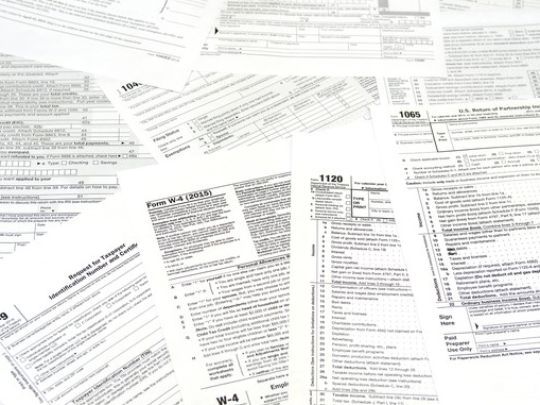 After working intently to shape the final tax cut legislation adopted by Congress shortly before Christmas, NMPF said the measure provides several important benefits for farmers and their cooperatives. NMPF had worked closely with House and Senate members on the once-in-a-generation tax package to achieve a positive outcome for the dairy community.
After working intently to shape the final tax cut legislation adopted by Congress shortly before Christmas, NMPF said the measure provides several important benefits for farmers and their cooperatives. NMPF had worked closely with House and Senate members on the once-in-a-generation tax package to achieve a positive outcome for the dairy community.
NMPF, along with the National Council of Farmer Cooperatives and others, urged lawmakers to preserve the economic value represented by the Section 199 deduction, which was eliminated as part of the tax package’s deep cut in corporate tax rates. The final compromise to address the loss of Section 199 will help protect farmer-owned businesses from a major tax increase at a time when America’s farm sector is struggling with low commodity prices and reduced incomes.
Also known as the Domestic Production Activities Deduction (DPAD), this important provision of the tax code applied to proceeds from agricultural products marketed through cooperatives, making the Section 199 an important means of reducing taxation for farmers and cooperatives alike. Cooperatives have passed the vast majority of the benefit to their farmer owners, and reinvested the remainder in infrastructure improvements for the processing and marketing of food products.
The final tax package repeals the DPAD, but the legislation allows cooperative members to claim a new 20-percent deduction on payments from a farmer cooperative. Cooperatives also will be able to claim the 20-percent deduction on gross income less payments to patrons, limited to the greater of 50 percent of wages or 25 percent of wages plus 2.5 percent of the cooperative’s investment in property.
In addition to the Section 199 issue, NMPF worked on several other components of the legislation of importance to the dairy sector, including:
- Depreciation. The bill would allow farms and other businesses to immediately write off 100 percent of qualified property costs through 2022. Current law allows businesses a 50 percent write-off for 2017, which decreases in the coming years.
- Expensing. The final bill expands the Section 179 provision made permanent by the PATH Act of 2015, thanks to NMPF’s support. The bill would adjust the maximum allowance from $500,000 to $1 million, which would revert back to $500,000 when the value of property put into service surpasses $2.5 million.
- Estate Tax Relief. NMPF has actively supported giving farmers additional relief from the federal estate tax, which taxes the transfer of farms between generations of family members. The final bill makes important progress on this issue, doubling the existing exemption to $11 million for individuals and $22 million for couples. Importantly, the package also preserves a full stepped-up basis for inherited property, avoiding what could have been another tax increase to offset reducing the estate tax.
- Interest Deductibility. The bill attempts to preserve the business interest deduction for most farmers. The package allows farms with less than $25 million in average annual gross receipts for the three prior taxable years to continue to deduct interest expenses.
- Cash Accounting. The package would continue to allow farms to use cash accounting.
- Like-Kind Exchanges. The bill would limit the use of Section 1031 like-kind exchanges to real property, removing their use for equipment.
- Environmental Stewardship. The bill allows the Section 48 Investment Tax Credit for solar energy to phase down after several more years, per the PATH Act of 2015, and does not renew Section 48 for any additional technologies. Therefore, the Agriculture Environmental Stewardship Act to expand Section 48 to cover nutrient recovery systems and digesters was unfortunately not incorporated into the bill. NMPF will seek other legislative opportunities to address this issue over the coming months.
NMPF expressed thanks to Sens. John Hoeven (R-ND) and John Thune (R-SD), as well as multiple House members, including Agriculture Committee Chairman Mike Conaway (R-TX), whose determined efforts to compensate for the loss of Section 199 will help prevent a higher tax bill for cooperatives and avert the loss of economic activity in rural communities that these businesses help generate.
“NMPF believes that this provision, plus components of the bill that increase exemption levels from the federal estate tax, enhance depreciation and expensing opportunities for producers, and preserve farmers’ ability to deduct interest expenses, should help farmers and cooperatives alike,” said NMPF President and CEO Jim Mulhern. “The compromise advanced by Sens. Hoeven and Thune recognizes that farmer cooperatives play an indispensable role in our nation’s economy and need to be treated fairly in the tax reform legislation.”
Congress Returns for Busy January Session to Address Several NMPF Priority Issues
January 05, 2018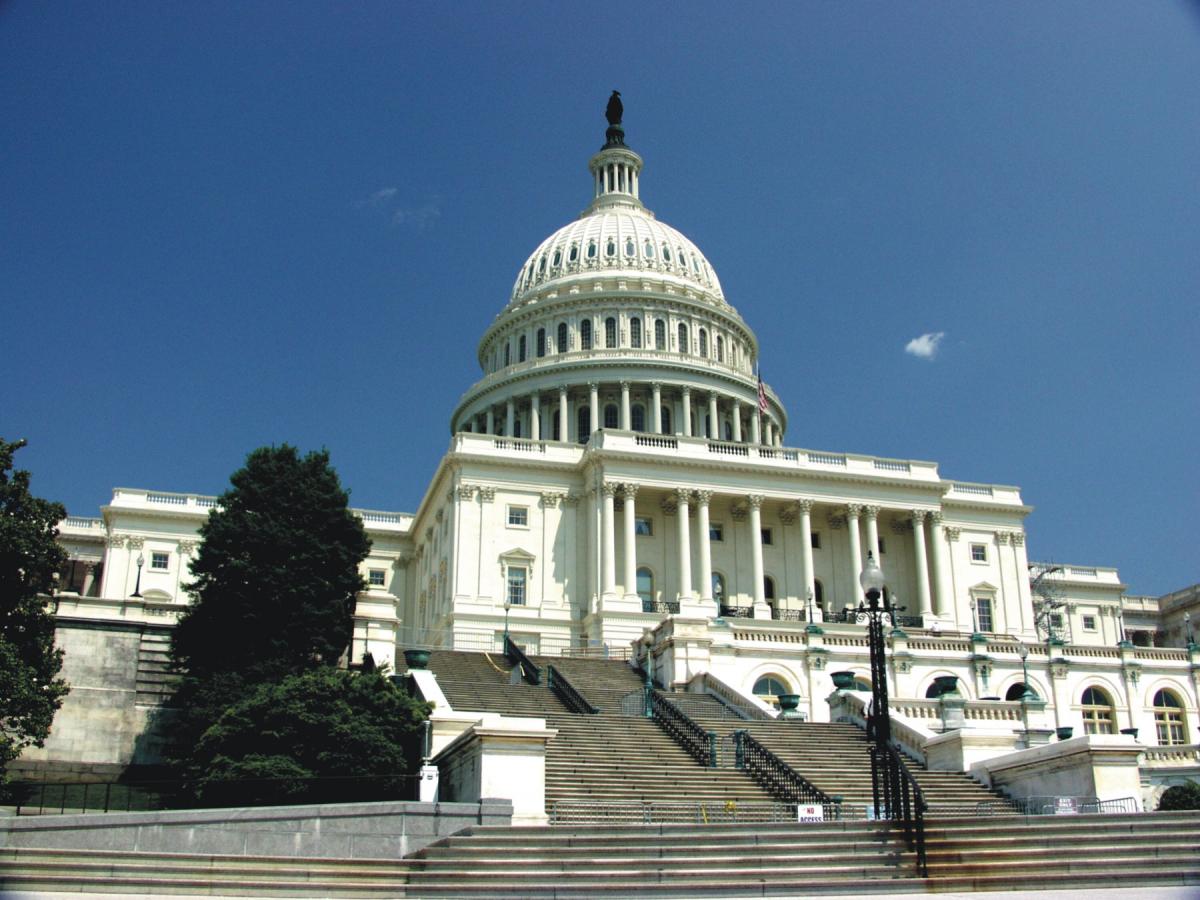 Congress returned to session on Jan. 3 with a substantial legislative roster ahead of it, including several items on NMPF’s priority list, such as securing disaster aid for farmers, passing a new Farm Bill and addressing immigration reform. In addition to these issues, Congress also must quickly focus on the federal budget, as a stop-gap funding package approved just before Christmas expires on Jan. 19.
Congress returned to session on Jan. 3 with a substantial legislative roster ahead of it, including several items on NMPF’s priority list, such as securing disaster aid for farmers, passing a new Farm Bill and addressing immigration reform. In addition to these issues, Congress also must quickly focus on the federal budget, as a stop-gap funding package approved just before Christmas expires on Jan. 19.
The House took tentative steps on farm policy prior to the end of 2017 by including assistance to dairy and cotton farmers in a larger disaster assistance bill intended to help states and communities ravaged by last fall’s severe hurricane season. NMPF applauded the House package for taking steps to improve risk management options for dairy farmers by eliminating the existing $20 million annual cap on the Livestock Gross Margin (LGM) program. This would enable USDA to offer coverage to more farmers in the current LGM program as well as provide new risk management approaches for dairy producers. As the bill moves to the Senate, NMPF is pushing to include badly-needed changes to the dairy Margin Protection Program (MPP) in the final version of the disaster bill. Combined, these actions would help pave the way for making final fixes to the dairy safety net program in the upcoming 2018 Farm Bill.
The government funding debate is an opportunity to address other NMPF priorities, including a solution to the pending air emissions reporting requirements for dairy farms and other livestock operations under CERCLA and EPCRA that have been triggered by a court decision [see later story]. NMPF is working closely with Congress, the U.S. Environmental Protection Agency (EPA) and industry partners to resolve this issue in a timely, effective manner.
Once Congress votes to fund the government past January, attention will shift to several other pressing items for 2018, including the Farm Bill. The House and Senate Agriculture Committees spent much of 2017 holding hearings and listening sessions, gathering stakeholder priorities, and beginning the drafting process. NMPF will continue to work closely with Congress to finalize and secure improvements to the dairy MPP to help ensure the program provides a meaningful safety net to all dairy producers.
Congress is also expected to address legislation on the soon-to-expire Deferred Action for Childhood Arrivals (DACA) program, which protects from deportation undocumented individuals who came to the United States as children. A legislative solution to this issue may provide an opportunity to focus on other pressing immigration issues, and NMPF will continue seeking all avenues to address dairy’s unique workforce challenges.
Take Enforcement Action Against Kite Hill’s “Almond Milk Yogurt,” NMPF Tells Regulators
January 05, 2018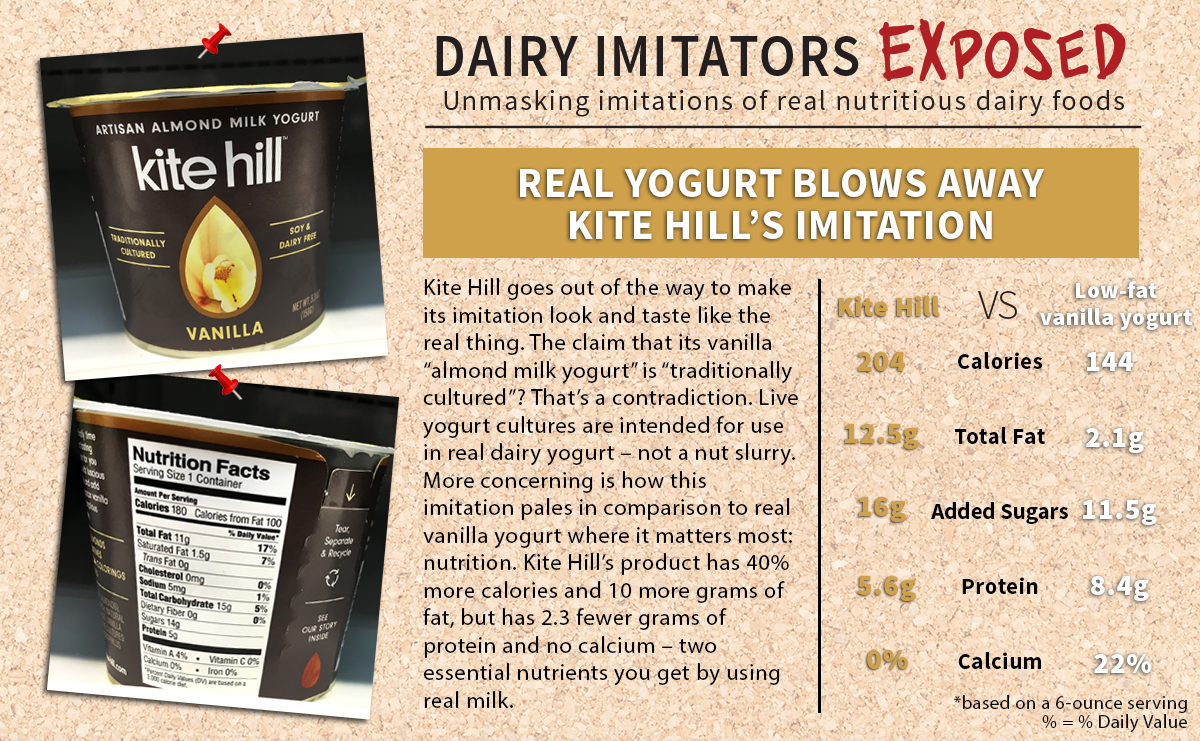 National Milk’s effort to prompt the enforcement of dairy-specific labeling terms took another step forward at the start of the new year when NMPF asked regulators to take action against Kite Hill, whose imitation yogurt products violate the federal definition for dairy foods and fail to provide the same nutrition as real yogurt.
National Milk’s effort to prompt the enforcement of dairy-specific labeling terms took another step forward at the start of the new year when NMPF asked regulators to take action against Kite Hill, whose imitation yogurt products violate the federal definition for dairy foods and fail to provide the same nutrition as real yogurt.
NMPF called out Hayward, California-based Kite Hill for illegally labeling its line of products and implying the nut-based foods are suitable substitutes for the real dairy foods it attempts to mimic. NMPF President and CEO Jim Mulhern said that Kite Hill’s line of products “is doubly deceiving, first as it declares the use of ‘almond milk’ as the main ingredient in their foods, and second in calling the resulting product ‘yogurt.’ A whitened slurry of nuts does not make milk, and adding bacteria to that mix and pouring it in a cup does not make yogurt.”
In letters sent in early January to the U.S. Food and Drug Administration (FDA) and California Department of Food and Agriculture, NMPF called out Hayward, California-based Kite Hill for illegally labeling its “yogurt,” which under existing federal regulations should be termed “imitation yogurt product.” The FDA standard of identity for yogurt defines a product made by culturing cream, milk, partially skimmed milk, or skim milk, alone or in combination, with specific lactic acid bacteria. NMPF said that “without real milk’s many nutrients as a base, this fake yogurt product fails to deliver the same nutrition as the real thing.”
NMPF also noted that the Kite Hill imitation delivers 40 percent more calories and 10 more grams of fat compared to an equivalent serving of vanilla yogurt, while providing one-third less protein and zero calcium.
A shareable infographic illustrating Kite Hill’s nutritionally inferior product is now on NMPF’s website as the latest installment in its “Dairy Imitators: Exposed” effort, which illustrates the nutritional disparities between imitation foods and real dairy foods, such as yogurt.
NMPF Advocates for U.S. Dairy at World Trade Organization Meeting in Argentina
January 05, 2018NMPF staff attended December’s World Trade Organization (WTO) ministerial meeting in Argentina to fight for U.S. dairy interests and ensure other countries abide by the global trading framework. In meetings with numerous key government officials and foreign industry counterparts, NMPF senior vice president Jaime Castaneda urged a renewed commitment to disciplines on tariff and non-tariff issues.
Ahead of the ministerial session, NMPF joined the U.S. Dairy Export Council (USDEC) and the International Dairy Foods Association (IDFA) in urging the U.S. Trade Representative (USTR) and U.S. Department of Agriculture to emphasize the U.S. dairy industry’s WTO trade priorities. The joint letter touted the importance of the WTO to dairy trade, noting that “it is the responsibility of all WTO members to uphold their existing trade commitments and engage constructively in exploring ways to further improve multilateral trade.”
Key U.S. dairy sector requests include opposing proposed new limits on U.S. domestic support while several large agricultural trading countries ignore current disciplines and refuse to meaningfully expand market access opportunities. The three organizations are also seeking to ensure that countries are not permitted to evade or undermine existing commitments, such as on export subsidies or price supports.
While at the conference in Argentina, Castaneda met with high-ranking USTR and USDA officials, as well as U.S. government embassy and State Department staff. The trip allowed further dialogue with South American leaders in government and industry on issues of mutual interest. This included the ongoing European Union-Mercosur trade agreement negotiations that could negatively impact U.S. export rights to the region. Those conferences also included meetings with both the chairman and the director general of the Pan-American Dairy Federation (FEPALE) regarding the pursuit of greater partnerships in Latin America to align the goals of the U.S. dairy industry with those in Latin America.
In a statement after the Ministerial, USTR maintained the importance of ensuring that countries abide by their WTO commitments, and affirmed the need for coordination with other like-minded countries on joint efforts in international forums such as the WTO, CODEX and the World Organization for Animal Health (OIE). NMPF will continue to work with the Trump Administration to advance global export opportunities for U.S. dairy products.
CCFN Wraps Up Busy Year Fighting for Rights to Common Food Names
January 05, 2018 The Consortium for Common Food Names’ (CCFN) work to protect common food names and safeguard global sales opportunities for cheeses finished the year with a flurry of important activity in key markets.
The Consortium for Common Food Names’ (CCFN) work to protect common food names and safeguard global sales opportunities for cheeses finished the year with a flurry of important activity in key markets.
In early December, CCFN, founded by NMPF and the U.S. Dairy Export Council, submitted detailed filings to all four Mercosur countries (Argentina, Brazil, Paraguay and Uruguay) opposing EU geographical indications (GIs) that would restrict the use of common food names. Mercosur and the European Union (EU) are nearing the end of free trade agreement negotiations, and the EU has been pushing hard to persuade Mercosur to provide them exclusive rights for hundreds of GIs. CCFN has worked extensively with local industry allies in Mercosur countries and through direct submission such as these filings to preserve market access rights for all in that major dairy region of the world.
Also last month, Japan announced the results of its own GI review process, in which CCFN, NMPF and USDEC were heavily engaged last year. As part of its free trade agreement with the EU, Japan announced its plans to register a lengthy list of GIs, but assured that many terms the EU had sought to monopolize would remain available for use by all, including parmesan, romano, provolone and others. CCFN will continue to work with Japan with the goal of ensuring that companies that have marketed common terms in Japan can keep using them moving forward, such as feta and asiago.
Also in December, efforts to conclude the EU-Mexico free trade negotiations stalled, and here again the EU’s bullying efforts on GIs was a major factor. As with Japan and Mercosur, the EU is seeking to persuade Mexico to restrict a host of common names as part of a GI registration process. CCFN has aggressively battled this EU effort to erase NAFTA market access rights, and that work continued with intense negotiations in mid-December that aimed to conclude the agreement. Talks will continue this year with a final few issues remaining – GIs among them – and NMPF will remain actively engaged in fighting to maintain Mexican consumers’ access to U.S. products.
These and other priority areas in the battle to preserve common name use and market opportunities for U.S. companies were among those NMPF discussed with U.S. Patent and Trademark Office (USPTO) attachés at a USPTO roundtable event in mid-December. NMPF conveyed the high stakes of this issue and updated attendees on CCFN’s global activities – many of which were conducted in conjunction with a number of those foreign-posted USPTO attaches last year. This strong partnership with U.S. government officials remains vital to CCFN success given recent EU efforts.
MPP Forecast: January 2018
January 05, 2018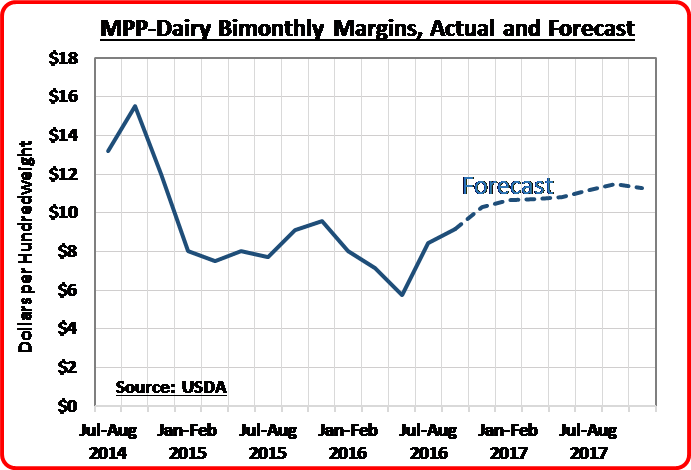 The monthly margin under the dairy Margin Protection Program (MPP) rose by $0.39/cwt from October to $10.39/cwt in November. The increase was generated by both a higher all-milk price, which rose by $0.20/cwt, as well as a $0.19/cwt drop in the MPP feed cost formula. Twelve cents of the feed cost drop were due to a decline in the corn price, $0.05 stemmed from a lower alfalfa hay price, and $0.01 resulted from a lower soybean meal price. The November monthly MPP margin was the highest since February 2017. The MPP monthly margin was last below $8.00/cwt in July 2016. The November monthly MPP feed cost was $7.71/cwt, the lowest since December 2016. The November all-milk price, $18.10/cwt., was the highest since February 2017.
The monthly margin under the dairy Margin Protection Program (MPP) rose by $0.39/cwt from October to $10.39/cwt in November. The increase was generated by both a higher all-milk price, which rose by $0.20/cwt, as well as a $0.19/cwt drop in the MPP feed cost formula. Twelve cents of the feed cost drop were due to a decline in the corn price, $0.05 stemmed from a lower alfalfa hay price, and $0.01 resulted from a lower soybean meal price. The November monthly MPP margin was the highest since February 2017. The MPP monthly margin was last below $8.00/cwt in July 2016. The November monthly MPP feed cost was $7.71/cwt, the lowest since December 2016. The November all-milk price, $18.10/cwt., was the highest since February 2017.
The CME dairy and grain futures currently suggest that the monthly MPP margin is on the verge of a steep drop, which would take it below $8.00/cwt for the first three or four bimonthly periods of 2018. The MPP feed cost is projected to rise slowly from its current level throughout 2018, but not likely gain more than one dollar above its November 2017 level. The all-milk price, on the other hand, is currently forecast to drop by almost $3 through this winter, driven by expected falling cheese and whey prices. These changes would bring the MPP margin down to $7.00 for the March-April period. The USDA MPP Decision Tool margin forecast for next year has also moved lower, but currently shows a stronger recovery in the MPP margin in the second half of 2018. As shown in the chart above, the USDA tool projects that the MPP margin will fall below $8.00/cwt. during the first half of 2018, based on the latest available update. Just a month earlier, the tool showed the margin remaining above that level throughout 2018.
USDA’s MPP margin forecasts are updated daily online. NMPF’s Future for Dairy website offers a variety of educational resources to help farmers make better use of the program.
CWT Helps Members Secure 7.2 Million Pounds of Cheese, Butter Exports in December
January 05, 2018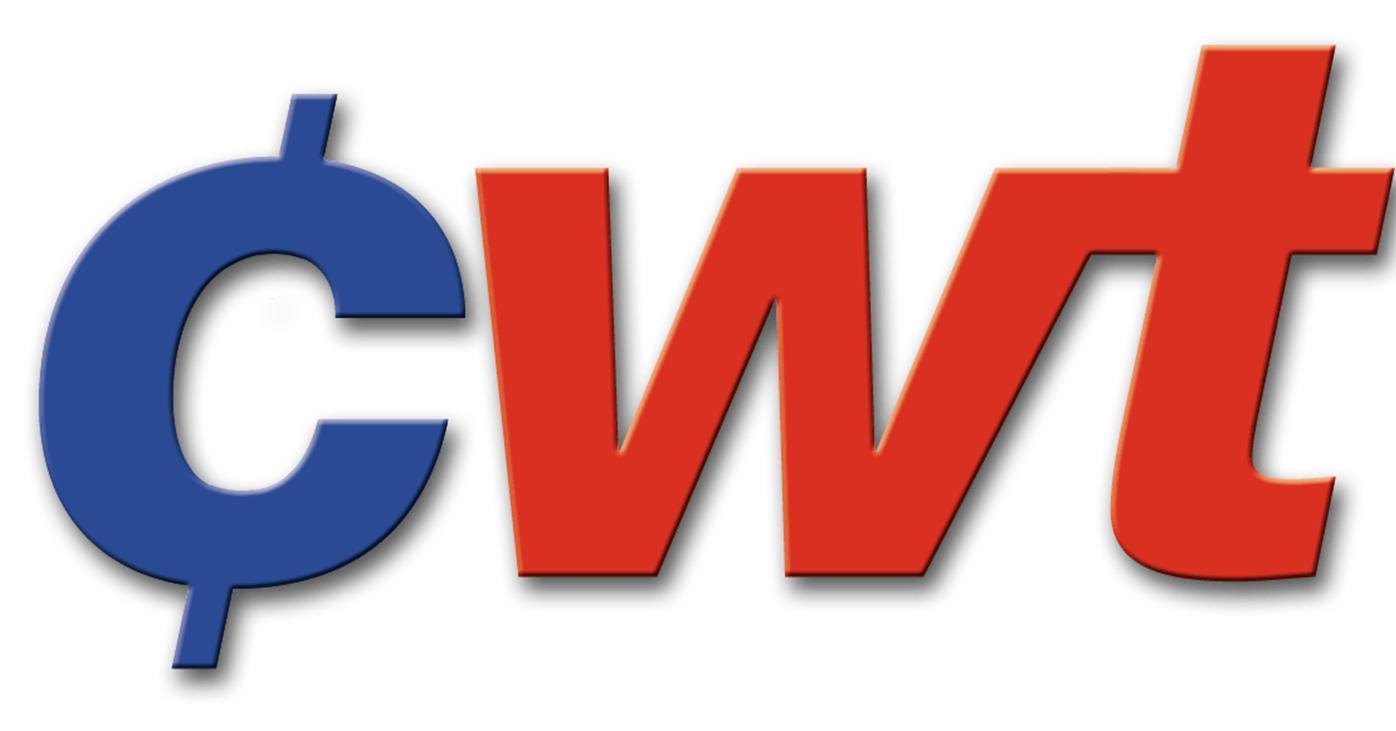 Cooperatives Working Together (CWT) helped member cooperatives secure 45 contracts to sell 6.06 million pounds of American-type cheeses and 1.10 million pounds of butter to customers in Asia, Central America, the Middle East, North Africa and Oceania. The product will be shipped in the months between December 2017 and March 2018.
Cooperatives Working Together (CWT) helped member cooperatives secure 45 contracts to sell 6.06 million pounds of American-type cheeses and 1.10 million pounds of butter to customers in Asia, Central America, the Middle East, North Africa and Oceania. The product will be shipped in the months between December 2017 and March 2018.
These transactions bring the 2017 total of CWT-assisted product sales contracts to 73.38 million pounds of cheese and 5.91 million pounds of butter. The product is going to customers in 21 countries in five regions, and will move overseas the equivalent of over 810 million pounds of milk on a milkfat basis.
Helping CWT member cooperatives gain and maintain world market share through the Export Assistance program in the long-term expands the demand for U.S. dairy products and the U.S. farm milk that produces them. This, in turn, positively impacts all U.S. dairy farmers by strengthening and maintaining the value of dairy products that directly impact their milk price.
The amounts of dairy products and related milk volumes reflect current contracts for delivery, not completed export volumes. CWT will pay export assistance to the bidders only when export and delivery of the product is verified by the submission of the required documentation.
All cooperatives and dairy farmers are encouraged to add their support to this important program. Membership forms are available on the CWT website.
CWT Helps Members Secure 7.2 Million Pounds of Cheese, Butter Exports in December
January 05, 2018 Cooperatives Working Together (CWT) helped member cooperatives secure 45 contracts to sell 6.06 million pounds of American-type cheeses and 1.10 million pounds of butter to customers in Asia, Central America, the Middle East, North Africa and Oceania. The product will be shipped in the months between December 2017 and March 2018.
Cooperatives Working Together (CWT) helped member cooperatives secure 45 contracts to sell 6.06 million pounds of American-type cheeses and 1.10 million pounds of butter to customers in Asia, Central America, the Middle East, North Africa and Oceania. The product will be shipped in the months between December 2017 and March 2018.
These transactions bring the 2017 total of CWT-assisted product sales contracts to 73.38 million pounds of cheese and 5.91 million pounds of butter. The product is going to customers in 21 countries in five regions, and will move overseas the equivalent of over 810 million pounds of milk on a milkfat basis.
Helping CWT member cooperatives gain and maintain world market share through the Export Assistance program in the long-term expands the demand for U.S. dairy products and the U.S. farm milk that produces them. This, in turn, positively impacts all U.S. dairy farmers by strengthening and maintaining the value of dairy products that directly impact their milk price.
The amounts of dairy products and related milk volumes reflect current contracts for delivery, not completed export volumes. CWT will pay export assistance to the bidders only when export and delivery of the product is verified by the submission of the required documentation.
All cooperatives and dairy farmers are encouraged to add their support to this important program. Membership forms are available on the CWT website.
NMPF Commends Maryland’s Efforts to Create Water Quality Trading Program
January 05, 2018 NMPF expressed support this month for the Maryland Department of Environment’s regulation to establish a water quality trading program, one that could serve as model for how other states provide opportunities for dairy farmers to benefit from the management of nutrients.
NMPF expressed support this month for the Maryland Department of Environment’s regulation to establish a water quality trading program, one that could serve as model for how other states provide opportunities for dairy farmers to benefit from the management of nutrients.
In its comments, NMPF endorsed the nutrient removal technologies that will be eligible to participate in the program – an issue the organization raised several times over the years as Maryland officials worked on the issue. NMPF also requested that trading not be limited in terms of time, and that a trading system with a duration of 10 or more years is needed to make the economics of nutrient removal technologies work. Otherwise, interest in technology-based nutrient removal solutions will not materialize. NMPF believes nutrient removal technologies can play an important role in the MDE’s trading program.
Unfortunately, Maryland’s plan to reallocate $10 million from the Bay Restoration Fund (BRF) to water quality trading for nutrient credit purchases did not come to fruition. Had the proposal been approved, it would have created enormous interest in the nutrient trading program. NMPF was also disappointed that piloting interstate trades within the Chesapeake Bay watershed suffered a similar fate. Regardless, NMPF commended both the MDE and the Maryland Department of Agriculture for creating the program and the rule. NMPF will continue to support Maryland effort to establish a workable water quality trading program.
FARM Program, Southeast Milk Hosts Meetings on Dairy Stewardship
January 05, 2018The National Dairy FARM Program, in conjunction with Southeast Milk Inc., Merck Animal Health and the University of Florida, hosted four dairy stewardship meetings and training sessions in three southern states from Dec. 11-15. The meetings helped emphasize the importance of implementing the FARM program’s Version 3.0 protocols, which became official at the start of 2017.
Owners and managers within Southeast Milk’s membership attended the trainings (pictured right), held in Louisiana, Georgia and Florida. During each one-day training courses, facilitators addressed potential vulnerabilities on the farm, discussed creating a culture of proper cow care, and shared resources for training on-farm employees.
These sessions are the foundation of a larger initiative developed by Southeast Milk to foster a culture of continuous improvement throughout the Florida dairy farm community, in light of customer and consumer expectations about animal care.
NMPF Accepting Applications for 2018 Scholarship Program
January 05, 2018 NMPF is now accepting applications for its National Dairy Leadership Scholarship Program for academic year 2018-2019. Applications must be received no later than Friday, April 6, 2018.
NMPF is now accepting applications for its National Dairy Leadership Scholarship Program for academic year 2018-2019. Applications must be received no later than Friday, April 6, 2018.
Each year, NMPF awards scholarships to outstanding graduate students (enrolled in master’s or Ph.D. programs) who are actively pursuing dairy-related fields of research that are of immediate interest to NMPF member cooperatives and the greater U.S. dairy industry.
Graduate students pursuing research of direct benefit to milk marketing cooperatives and dairy producers are encouraged to apply (applicants do not need to be members of NMPF to qualify). The top scholarship applicant will be awarded the Hintz Memorial Scholarship, which was created in 2005 in honor of late Cass-Clay Creamery Board Chairman Murray Hintz, who was instrumental in establishing NMPF’s scholarship program.
Recommended fields of study include, but are not limited to: Agriculture Communications and Journalism, Animal Health, Animal and/or Human Nutrition, Bovine Genetics, Dairy Products Processing, Dairy Science, Economics, Environmental Science, Food Science, Food Safety, Herd Management, and Marketing and Price Analysis.
For an application or more information, please visit the NMPF website or call the NMPF office at 703-243-6111.
2017 NMPF Dairy Data Highlights Now Available
January 05, 2018The 2017 edition of NMPF’s Dairy Data Highlights is now available to order.
The Dairy Data Highlights booklet is an extensive collection of tables and graphs that provides national and state data on all aspects of milk production, federal milk marketing orders, sales of milk and dairy products, farm and retail prices, and dairy product production, as well as dairy export and import information through 2016. It has been published annually by NMPF for more than 60 years.
Copies of the current Dairy Data Highlights are available at the following rates:
NMPF member cooperatives or associate members:
Fewer than 10 copies: $7.50/booklet
Orders larger than 10: $5.00/booklet.
Non-members:
Fewer than 10 copies: $10/booklet
Orders larger than 10: $7.50/booklet.
To purchase copies, complete an order form and mail it back to NMPF with payment. We accept checks or money orders. Checks should be made payable to the National Milk Producers Federation. Booklets will be mailed upon receipt of payment. The booklet is not available electronically.
Court Action in January May Trigger Air Emissions Reporting Requirement
January 05, 2018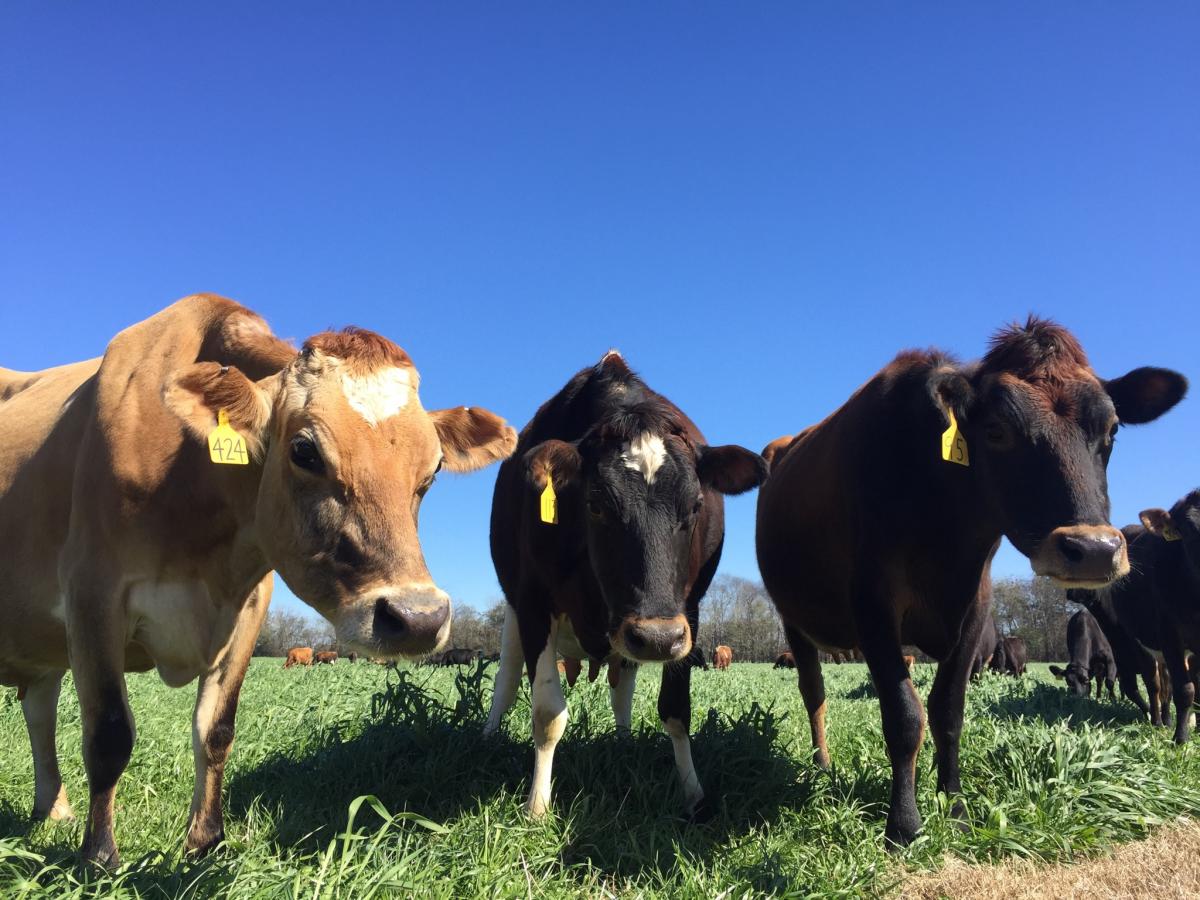 National Milk continues to advise dairy farmers not to file ammonia-related air emissions reports until an appeals court issues a mandate that triggers a reporting requirement – an action that could be taken later this month.
National Milk continues to advise dairy farmers not to file ammonia-related air emissions reports until an appeals court issues a mandate that triggers a reporting requirement – an action that could be taken later this month.
At issue is the extent to which livestock operations will have to report manure-related emissions under the Comprehensive Environmental Response, Compensation, and Liability Act (CERCLA) regulation, and the Emergency Planning Community Right to Know Act (EPCRA). In 2008, EPA provided a broad exemption of all livestock operations from reporting requirements. However, last April, a federal appeals court ended EPA’s exemption for reporting of livestock air emissions under CERCLA/EPCRA, following legal challenges made by activist groups.
EPA sought and was granted additional time from the court to delay the effective compliance date so that the agency could develop materials to help farmers understand their obligations. In late October, the EPA filed a motion requesting that the stay remain in place until January 2018. The D.C. Court of Appeals should issue its mandate by Jan. 22, which may trigger reporting for many dairy producers.
EPA estimates that a single dairy cow emits 0.07 pounds of ammonia per day. Given that the ammonia threshold is 100 pounds per day, NMPF estimates that it will take approximately 1,428 cows to trigger reporting to the National Response Center. EPA has said that no one is obligated to use the 0.07 emission factor, and instead says farmers “may establish estimated quantities of releases by relying on: past release data, engineering estimates, your knowledge of the facility’s operations and release history, or your best professional judgment.”
Once the mandate is issued, if a farm has more than 1,428 cows, operators should consider reporting to the National Response Center via email within 24 hours of understanding the reporting obligation. Dairy operators must identify the reportable release as an “initial continuous release notification,” then submit an initial written notification to the EPA Regional Office within 30 days, and one year later submit an additional follow-up written notification to the EPA Regional Office.
For farms with fewer than 1,428 cows, NMPF suggests calculating emissions on paper, signing and dating it in front of a notary, and keeping it on file to defend against activists who may try to initiate litigation against livestock operations. NMPF staff are prepared to assist dairy operators with compliance efforts if the emissions reporting requirement is implemented in the coming weeks. Contact Clay Detlefsen for more information.
Further, farm owners and operators in compliance with their Animal Feeding Operation Air Compliance Agreement are not expected to report air releases of hazardous substances from animal wastes under CERCLA and EPCRA. Per that agreement, participants must report air releases of hazardous substances equal to or exceeding the hazardous substances’ reportable quantities under CERCLA only when EPA completes the National Air Emissions Monitoring Study.
NMPF continues to work with other animal agriculture organizations, EPA and members of Congress to find a long-term solution that will preclude the need to file air emission reports stemming from the natural decomposition of manure.
DHS Says Certain Farms’ Hydrogen Peroxide Use May Not Comply with Chemical Security Rule
January 05, 2018An 11-year-old law intended to minimize the risk of terrorist attacks in the U.S. may require dairy farmers to adjust their use of hydrogen peroxide as a sanitizer, based on information shared recently with NMPF by the Department of Homeland Security.
In 2007, Congress required the DHS to create a Chemical Facility Anti-Terrorism Standards (CFATS) program. The program identifies and regulates high-risk chemical facilities to ensure they have security measures in place to reduce the risk of a terrorist attack using certain chemicals. The CFATS regulation lists more than 300 chemicals of interest (COI) which, if held in specified quantities or concentrations, trigger reporting requirements to DHS. Facilities are required to report their chemical holdings within 60 days of coming into possession of a COI.
To assist agriculture, DHS granted an indefinite time extension for certain activities at agricultural facilities. The extension applies to chemicals used for soil preparation and the treatment of crops, feed, land, livestock, or other areas of an agricultural production facility (for example, ammonia used as a fertilizer falls under the extension, but propane for fuel or hydrogen peroxide for cleaning and water treatment must be reported).
In the past year, DHS has been visiting agricultural operations that may have their chemical use covered by the indefinite exemption. DHS has inspected several dairy farms where chemicals used to clean equipment and hydrogen peroxide was used to treat water – both potentially non-exempt activities. DHS subsequently contacted NMPF staff and asked for help in sharing the chemical security requirements with dairy producers.
Regarding hydrogen peroxide, the rule states that hydrogen peroxide with a 35% or higher concentration is a Chemical of Interest. If the concentration is below 35%, it is not a COI and it will not trigger reporting. NMPF urges dairy producers using hydrogen peroxide on their farms to immediately begin using a solution less than 35%, or ensure they have less than the threshold reporting quanitity of 400 pounds on site at any time. NMPF staff are also exploring whether other chemicals being used could trigger the rule. More information can be found here. Otherwise, contact Clay Detlefsen .





